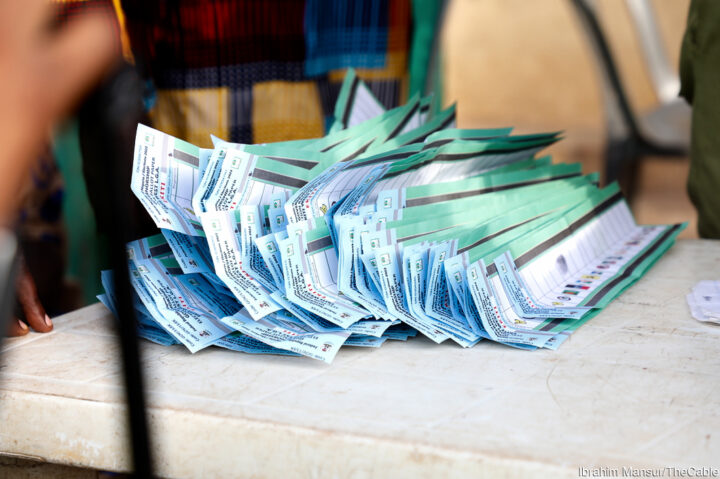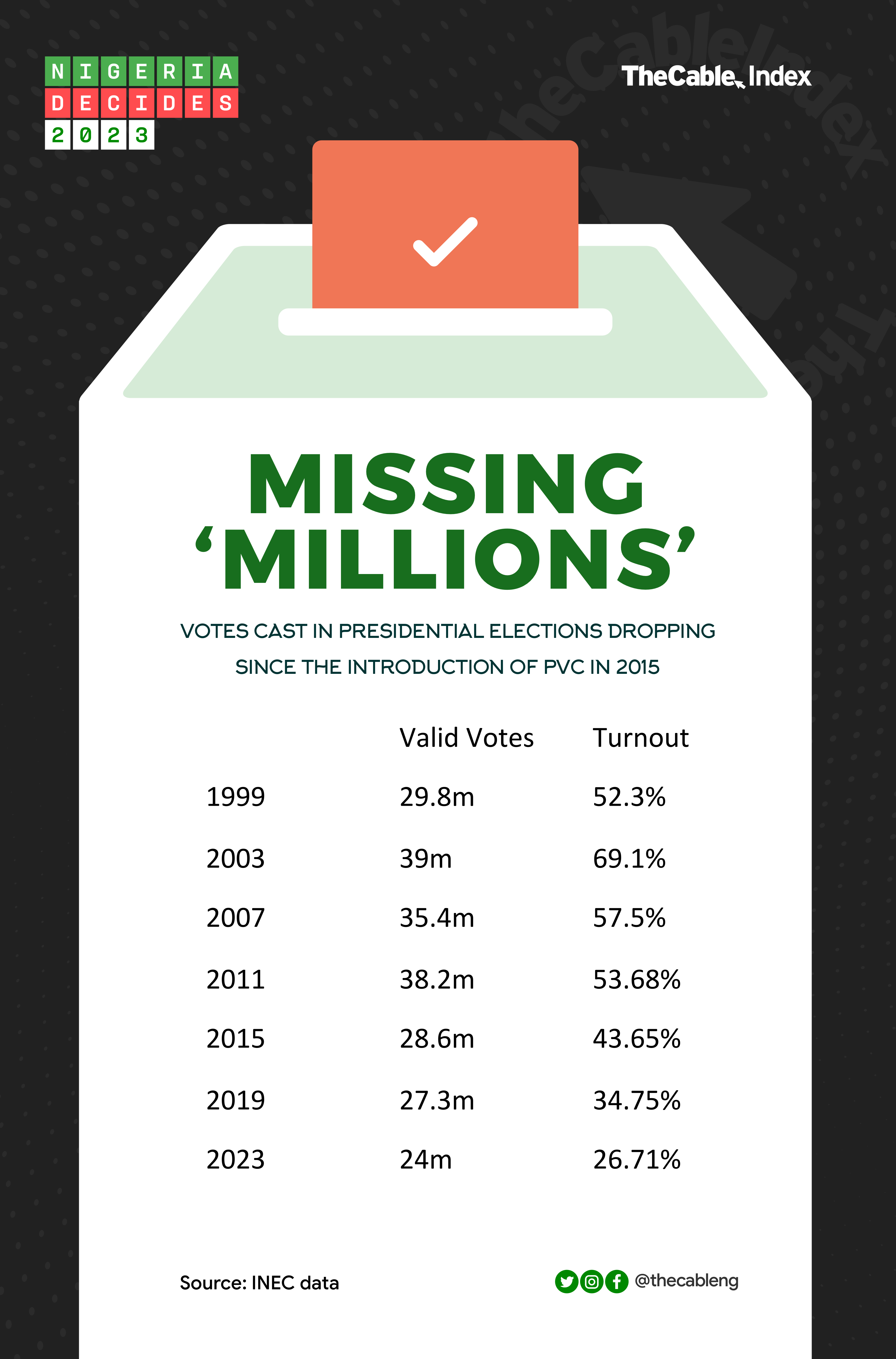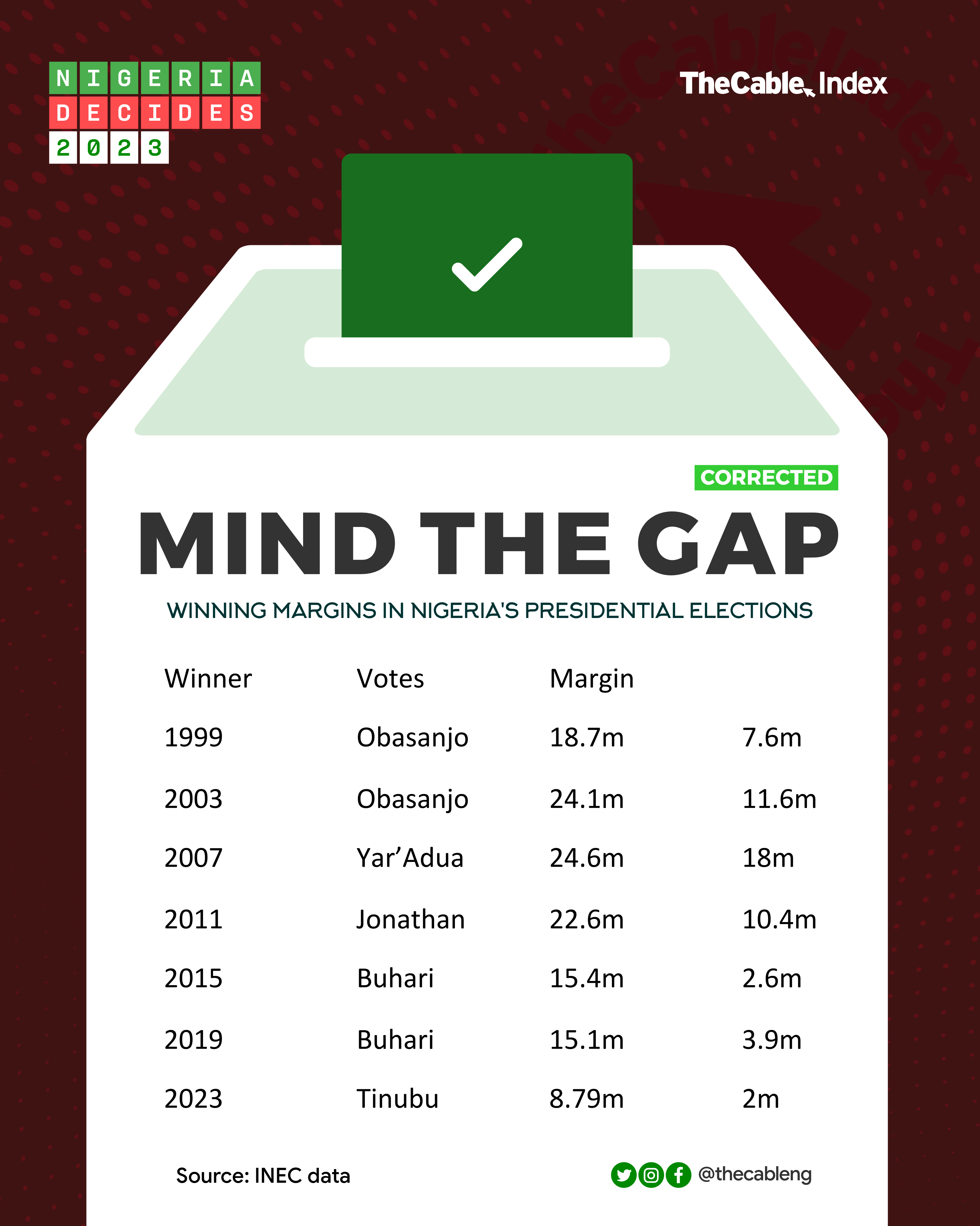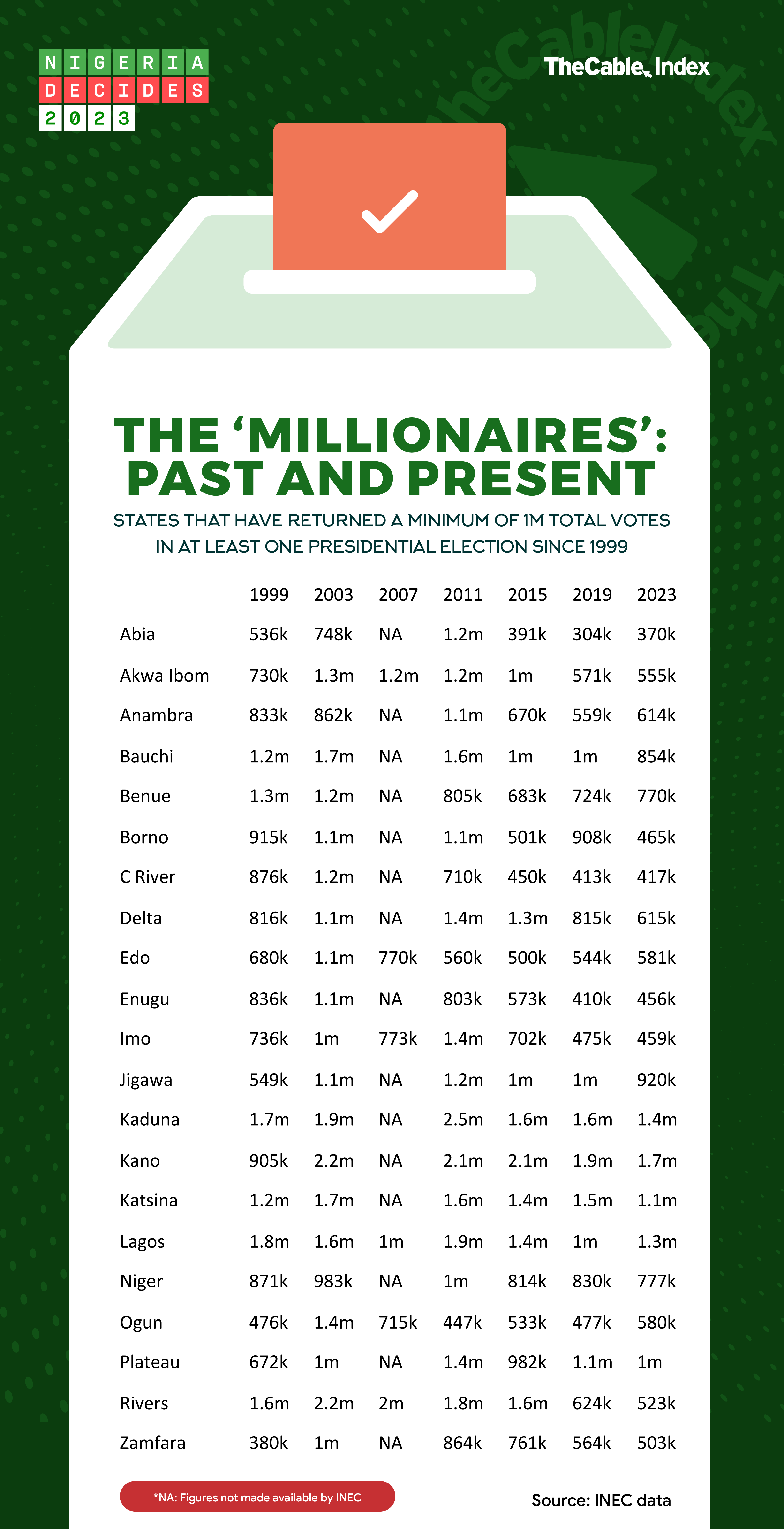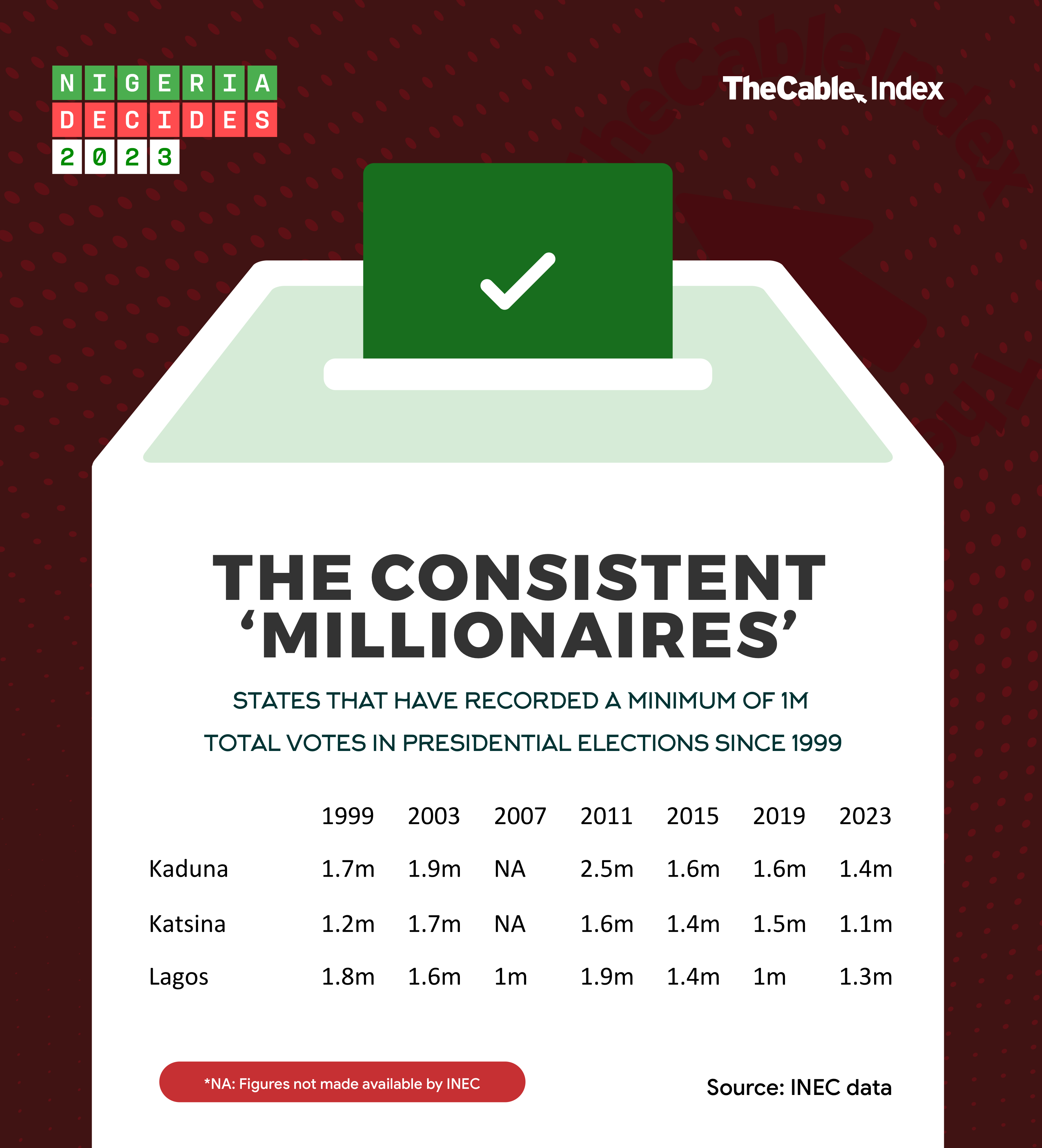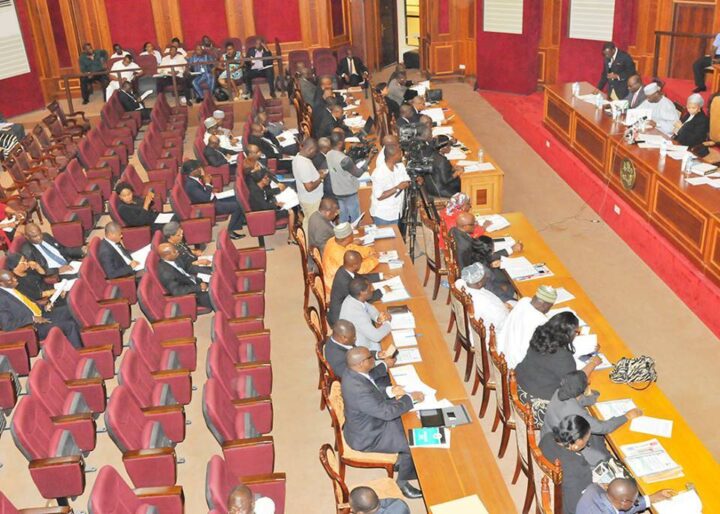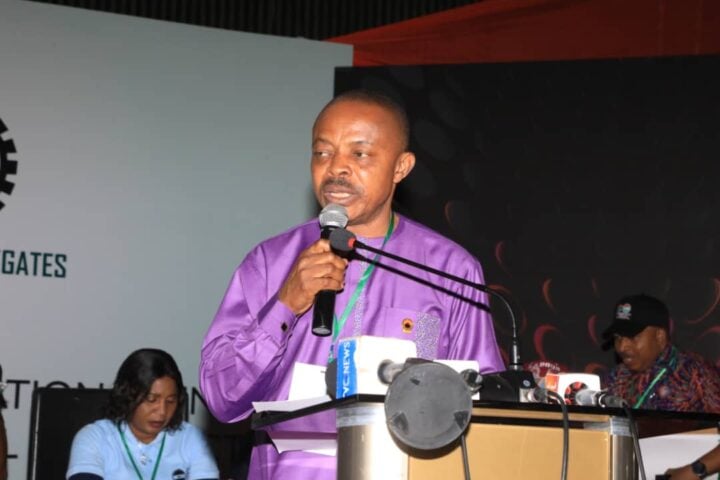Where have all the millions gone?
This is a question that startled TheCable data crunchers when they went through the official comprehensive data for Nigeria’s presidential elections since the fourth republic was birthed 24 years ago.
In 1999, 29.8 million Nigerians voted in the presidential election that brought President Olusegun Obasanjo to office. Exactly 24 years after, only 24 million voted, representing a drop of 5.8 million.
The highest turnout was in 2003 when 39 million people — representing 69.1 percent of registered voters — cast their ballots. This contrasts with 2023 when only 26.71 percent voted, representing one in four registered voters and one in eight Nigerians overall. The 2023 figure is the lowest ever.
Advertisement
Since the height of 2003, the percentage turnout has been on a downward trend: 57.5 percent in 2007, 53.68 percent in 2011, 43.65 percent in 2015 and 34.75 percent in 2019.
The absolute numbers rose from 35.4 million in 2007 to 38.2 million in 2011 but have been dropping since then: 28.6 million in 2015, 27.3 million in 2019 and 24 million in 2023.
Advertisement
WHY ARE THE NUMBERS DROPPING?
There are various factors that can explain the continuous drop in numbers, but the most obvious is the introduction of the biometric permanent voter card (PVC). In the past, voters were registered manually and this allowed for multiple registrations and multiple voting.
In 2007, the electoral body decided to go digital but stopped at the registration level and no PVCs were used. There was still space for multiple registrations and multiple voting as the registers were not “cleaned up”. In many cases, figures were merely written without actual voting.
In 2011, the move to better technology was stalled, perhaps because of a change of leadership at the commission — but it was finally introduced in 2015 with the use of card-reading machines that authenticated the PVCs and accredited the voters.
In theory, this would prevent double voting. In practice, there were loopholes — INEC allowed for the card readers to be bypassed and “incident forms” filled if there was a technical hitch. This gave room for the padding of figures in some places.
Advertisement
Votes nonetheless dropped by nearly 10 million — from 38.2 million in 2011 to 28.6 million in 2015 — most probably because of the impact of technology.
The number further dropped in 2019 as well, with only 27.3 million casting valid votes.
In 2023, the turnout dropped to its lowest so far by about 3.3 million votes.
The drop might also have been a result of the introduction of the bimodal voter accreditation system (BVAS) which not only authenticated the PVCs but also recorded the number of accredited voters, with INEC eliminating the use of “incident forms”.
Advertisement
Generally, there may be a need for INEC to do a comprehensive clean-up of the register because of those who have died or relocated from the country. The idea of 93 million registered voters does not look feasible any longer.
Advertisement
WINNING MARGINS GOING DOWN
Since the introduction of PVCs and card readers/BVAS, the winning margins for the presidential candidates have dropped significantly.
Whereas Goodluck Jonathan defeated Muhammadu Buhari by 10.4 million votes in 2011, Buhari won the return match in 2015 — when the card readers were introduced — by just 2.6 million votes.
Advertisement
Buhari was re-elected in 2019 by a higher margin — 3.9 million — but nowhere near the 18 million recorded against him by Umaru Musa Yar’Adua in 2007.
Obasanjo’s 11.6 million in 2003 comes next but the lowest ever is Bola Tinubu’s 2,010,206 above Atiku Abubakar in the 2023 poll.
Advertisement
BUT WHAT HAPPENED TO THE ‘MILLIONAIRES’?
Times were, before the introduction of PVC and card readers/BVAS, when states were churning out millions of votes.
Save for the 2007 presidential election when INEC provided the full results only for nine states and the Federal Capital Territory (FCT), TheCable data boffins examined all the figures provided since 1999.
It is not surprising that many states were churning out millions of votes before the introduction of improved technology.
In 2003 alone, 18 states recorded at least one million votes each, with both Kano and Rivers each returning 2.2 million. The undercurrent was that Buhari, Obasanjo’s challenger, was popular in Kano and the sitting president needed to balance the equation elsewhere.
But while Buhari got 1.628 million votes in Kano, Obasanjo got an all-time record 2.003 million votes in Rivers. No individual has secured that figure since then. For context, Buhari got only 42,346 votes in Rivers, compared to Obasanjo’s 492,755 votes in Kano.
THE REAL AND FAKE ‘MILLIONAIRES’
While 18 states returned a minimum of 1m+ votes each in 2003, only five did so in 2023 — the lowest ever, bar the 2007 results that are not available. Many will see the 2023 data as a sign of Nigeria getting closer to the real voting figures.
In 2011, there were 15 states with 1m+ votes, but this dropped to nine states when PVC and card readers were used. It further dropped to seven in 2019. Only six states returned 1m+ votes in 1999.
Some states have been consistent with 1m+ votes since 1999: Kaduna, Katsina and Lagos. Since Kano joined the club in 2003, it has never looked back. Bauchi, by contrast, had been recording 1m+ since 1999 but fell out this year.
However, there are eight states that recorded 1m+ only once: Cross River, Edo, Enugu, Ogun, and Zamfara — all in 2003 when Obasanjo was seeking a second term. Only Zamfara did not vote Obasanjo that year. It gave Buhari 843,159 votes and Obasanjo 200,702.
The other one-time “millionaires” are Abia, Anambra and Niger. This was in 2011. Jonathan scored 1m+ in Abia and Anambra, further getting 321,429 in Niger where Buhari won with 625,574.
Now, how about this? The highest single turnout ever in a state was recorded in Kaduna in 2011 when 2.5 million people voted. Buhari got 1,334,244 votes to beat Jonathan who scored 1,190,179. That record is going to be difficult to beat, especially with the advent of PVC and BVAS.
When you look at some of these figures dispassionately, you will see the devil somewhere in the details.
All turnout statistics used in this analysis are based on the record of valid votes made public by the Independent National Electoral Commission (INEC). Invalid votes are discountenanced.
Add a comment
